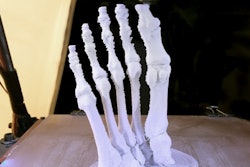
2016 was an exciting year for 3D printing in healthcare. Big investments, mergers and acquisitions, and strategic partnerships from front-runners of the industry seem to mark the beginning of an exciting new era. The following are what I believe were the top 10 3D printing events of 2016.
1. Stryker buys a 3D printing 'farm,' January 2016
2016 started with a bam after Stryker announced its new 3D printing facility costing upward of $400 million. Fully aware of the competitive landscape of medical implants, Stryker's investment in 3D printing is in alignment with its innovative culture. Immediately following that, in March, Stryker received clearance from the U.S. Food and Drug Administration (FDA) for its 3D-printed spinal fusion device, not the first in the company's history. Also, because of intrinsic technical advantages of 3D printing, using the technology as a production tool may also save the company money in the long run, especially in light of the increasing number of 3D-printed implants cleared by the FDA.
 Neuroradiologist Dr. Jenny Chen.
Neuroradiologist Dr. Jenny Chen.2. Johnson & Johnson partners with Carbon3D for surgical devices, January 2016
What Johnson & Johnson is up to next has been the focus of 3D printing and healthcare lately, as its increasing interest in digital manufacturing is becoming very clear. This can be traced back to its partnership with Organovo a few years ago, and to its emphasis on personalized medicine and precision medicine. Given Carbon3D's continuous liquid interface production (CLIP) technology, a formidable collection of materials, and a strong life science division including ex-FDA experts, the partnership will prove exciting to the entire industry in the next few years.
3. 3D Systems announces state-of-the-art healthcare technology center, March 2016
3D Systems has a long history of involvement in healthcare. To date, it is still the main partner with Align Technology, serving as the best example of mass customization. After several acquisitions ranging from Medical Modeling to Simbionix, it is finally consolidating its multiple lines of products ranging from simulation tools to implants into a comprehensive design and production center for healthcare solutions.
4. Formlabs announces its first biocompatible resin, Dental SG, April 2016
A leader in desktop stereolithography (SLA) printing technology, Formlabs announced class I biocompatible resin this year. The most immediate beneficiary is the dental community, where there is an increasing interest in bringing multiple manufacturing processes in-house, ranging from surgical guides to braces and dental crowns, among others. More printer choices and material selection from the desktop 3D printing community can not only make many existing procedures cheaper and faster, but also encourage more innovations in a clinician's office.
5. Stratasys, Materialise, and more collaborate with clinical partners, April and May 2016
In recent years, more and more physicians are open to 3D printing as a surgical simulation tool. Many consider it more useful than existing 2D medical imaging or computational simulation in improving operational safety and outcomes by providing additional visual and haptic experiences for the surgeon before the actual surgery. However, lack of reimbursement due to insufficient clinical evidence makes a wider adoption of the technology challenging. In April, Stratasys announced its strategic partnerships with the Jacobs Institute for clinical studies and innovations. Immediately following that, another industrial giant, Materialise, announced its support for clinical trials and collaboration with healthcare providers during the Rapid conference. These partnerships among industrial leaders and major clinical and research institutes will undoubtedly accelerate data accumulation and innovation in the next few years.
6. FDA issues 3D-printing guidance for medical devices, May 2016
This news is probably the most important announcement for the field of healthcare 3D printing, no matter what part of the ecosystem you belong to. Readers can also find the latest updates on the FDA website. The guideline in many ways will dictate the direction of future innovations and business strategies.
7. HP delivers first ready-to-print 3D printing system, collaborates with Materialise, Siemens, and Autodesk for software, May 2016
HP claims that its Jet Fusion 3D printing technology delivers parts up to 10 times faster and at half the cost of current 3D printing systems. Speed and cost are two critical (and sometimes lifesaving) factors in healthcare products, especially if production rather than prototyping is the end goal. Additionally, its open software and material platform will significantly accelerate the potential for innovative use in healthcare, as high costs in these areas have been prohibitive in the past.
8. GE makes billion dollar purchase, September 2016
This year, GE bought itself two expensive early Christmas gifts: the large metal 3D printing companies Arcam AB and SLM Solutions Group. Both companies have a long history of products in both aerospace and healthcare verticals, and GE itself has an extensive healthcare portfolio. Having these two companies will lower costs due to in-house innovation cycle and production and will also add implant and medical device market share for GE.
9. TeraRecon and WhiteClouds partner for healthcare solutions, November 2016
During the RSNA 2016 meeting, the two companies announced their partnership to provide an enterprise-level, one-button solution to create 3D printing simulation models for doctors. This is a first-of-its-kind collaboration between a 3D printing service bureau and a medical software company, signifying the value medical providers place on a more streamlined digital workflow.
10. Organovo launches second commercial product, December 2016
Last but not least, Organovo ended the year with an uplifting announcement that it will launch its second commercial product, focusing on kidney tissue. This is a natural extension of the company's existing liver tissue product. Although total organ production remains in the realm of "Westworld," advancements in commercial bioprinting and tissue engineering now allow for a much shorter pharmaceutical R&D cycle, reducing costs and avoiding tough ethical questions raised in animal testing. The additional unspoken benefit of intellectual property (IP) protection by keeping drug development in-house will also manifest itself as globalization increases in drug development.
Dr. Jenny Chen is a neuroradiologist and adjunct clinical faculty member in the radiology department at Stanford Health Care. She is also founder and CEO of 3DHeals, an organization designed to foster a global collaborative and innovative healthcare 3D printing ecosystem, with the group's annual meeting to be held April 19-20 in San Francisco. Her main interests include medical education, 3D printing in the healthcare sector, and artificial intelligence.
The comments and observations expressed herein are those of the author and do not necessarily reflect the opinions of AuntMinnie.com.



















